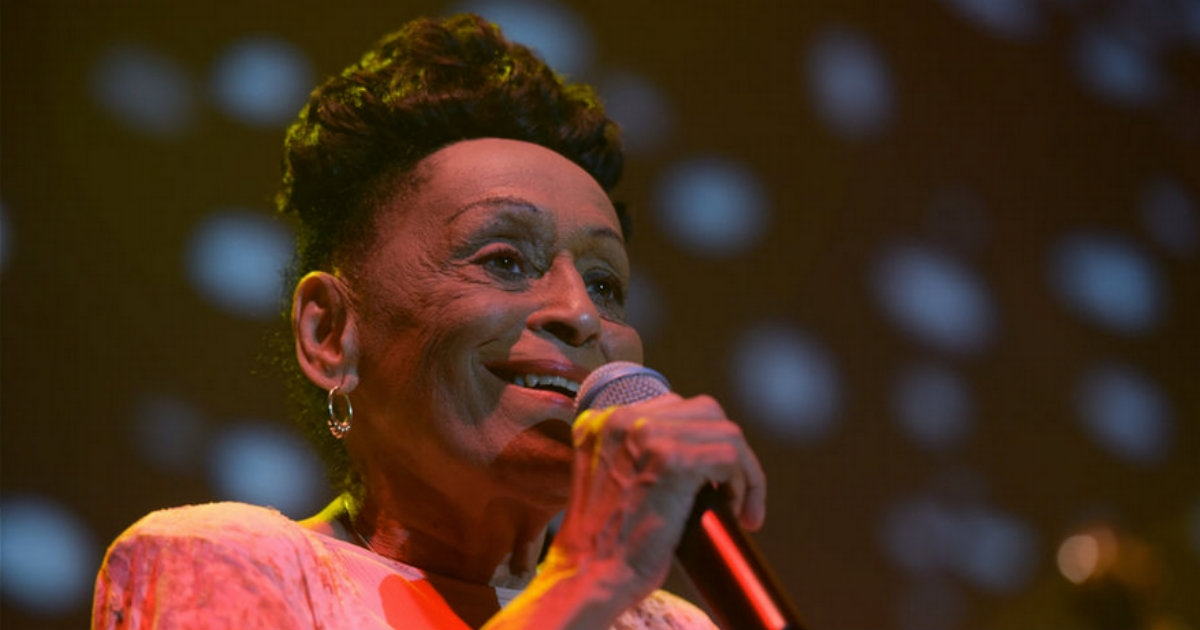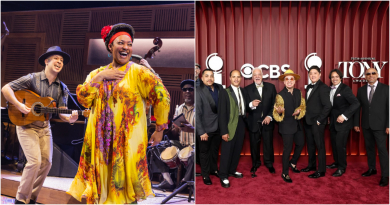
Omara Portuondo Peláez is one of the most important feeling singers from Cuba of all time. She was born in Havana, Cuba on October 29, 1930.
Her mother belonged to a Cuban family of noble lineage of Spanish descent, and it was expected that she would marry someone who would connect her to other families in society. However, she ran away with the man she loved, a baseball player from the national team. The marriage had three daughters, and like in any Cuban home, there was music; they had no money, but they had the voices of their parents singing in the kitchen while they went about their daily lives. Omara, who was born in the Cayo Hueso neighborhood of Havana, remembers her songs, including among her favorites "La bayamesa" by Ernesto Grenet and Sindo Garay (also sung by Compay Segundo in Buena Vista Social Club). These were her first informal singing lessons, and these songs became part of her lifelong repertoire.
When her sister Haydée became a dancer at the famous Tropicana cabaret, Omara soon followed her, by accident: the dance company was short one dancer one day in 1945 when a performer withdrew just two days before an important premiere. Omara had seen her sister rehearse so often that she knew all the steps, so they asked her to fill the vacant spot. “It was a very chic cabaret, but I said it was unacceptable,” remembers Omara. “I was very shy and felt embarrassed to show my legs.” But her mother convinced her by saying that she couldn't let them down; thus began her career as a dancer, forming a famous duo with dancer Rolando Espinosa.
On weekends, Omara and Haydée would sing jazz standards with some friends: César Portillo de la Luz, José Antonio Méndez, and pianist Frank Emilio Flynn. They called themselves Loquibambla Swing, and the style they played, a Cubanized version of bossa nova with influences from jazz, became known as “feeling” or, in Spanish, “filin.” In their radio debut, Omara was introduced as Omara Brown, the girlfriend of filin. That stage name was soon forgotten, but not the definition that accompanied it.
En 1950 fue integrante de la Orquesta Anacaona, y hacia 1952 Omara y su hermana Haydée Portuondo formaban un cuarteto vocal femenino con Elena Burke and Moraima Secada, liderado por la pianista Aída Diestro. Se convirtieron en uno de los cuartetos vocales más importantes de la música cubana y Omara permaneció con el Cuarteto Las De Aída durante 15 años, aunque la formación original solo grabó un álbum para RCA Víctor en 1957. Realizaron numerosas giras por América con innovadores arreglos vocales de Aída; tuvieron oportunidad de compartir escenarios con Édith Piaf, Pedro Vargas, Rita Montaner, Bola de Nieve, and Benny Moré y también sirvieron como acompañantes de Nat King Cole cuando este se presentó en Tropicana.
He made his solo debut with the album Magia negra, released in 1959, which blends Cuban music and jazz and includes covers of That Old Black Magic and Caravan by Duke Ellington. He then continued with Las De Aída until 1967, the year in which he finally focused on his solo career, performing in Cuba and at various international festivals representing the country.
In the 1970s, she performed with the Orquesta Aragón and traveled extensively, presenting in various countries such as France, Japan, Belgium, Finland, and Sweden. Omara made numerous recordings over the following two decades; however, the best is considered to be the album she recorded with Adalberto Álvarez in 1984 and two recorded for the Spanish label “Nubenegra”: “Palabras” and “Desafíos.”
The Cuban director Fernando Pérez Valdés made a documentary about the singer titled Omara, in 1983.
In 2000, World Circuit released Buena Vista Social Club presents... Omara Portuondo, the third album by this group which featured musicians such as Rubén González, Orlando ''Cachaíto'' López, Manuel ''Guajiro'' Mirabal, and Jesús "Aguaje" Ramos, along with guest appearances by artists like Eliades Ochoa, Compay Segundo, Manuel Garban, and Ibrahim Ferrer.
The album, received with great acclaim from critics, led Omara on a world tour in 2000-2001 with her Buena Vista colleagues, Rubén González and Ibrahim Ferrer.
In 2002, he embarked on an extensive solo international tour, with numerous dates in North America and Europe. In the fall of the same year, he participated in the Jazz Festival in Japan.
In 2003, he/she went on a tour of Canada and the United States.
In September 2003, he recorded at the EGREM studios what would become his second solo album produced by World Circuit.
The album Flor de amor marks a shift in direction, and the combination of Cuban musicians with a selection of Brazilian artists gives the record a unique sound.
On November 5, 2009, she won the Latin Grammy Award in the category of Best Contemporary Tropical Album with Gracias, but what is significant is that she became the first Cuban artist residing in her country to win this prestigious award and collect it with her own hands. In the album, Omara takes a journey through her 60 years of artistic career, featuring special contributions from Cubans Silvio Rodríguez and Pablo Milanés, Uruguayan Jorge Drexler, and Brazilian Chico Buarque.
In 2010, she recorded a song for the Spanish version of the movie The Princess and the Frog, titled Taina y el sapo, by Walt Disney, performing a song by the elderly Mama Odie: Dig a Little Deeper. For the soundtrack of the Latin American version, titled La princesa y el sapo, she did not record any song.
In September 2020, she was nominated for her album Mariposas for the award of 'Best Contemporary Tropical/Fusion Album' at the Latin Grammy 2020.
In October 2020, in celebration of her 90th birthday Portuondo gave an online concert alongside flutist Ethiel Faílde, during which she performed songs such as "20 años" and "Dos Gardenias," both of which have been significant in her musical repertoire over the years.

